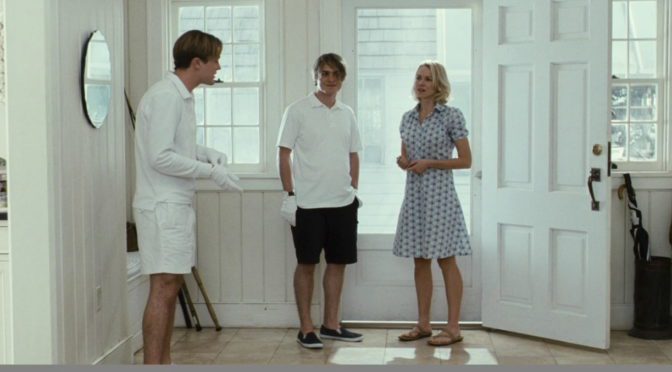“You shouldn’t forget the importance of entertainment.”
Horror films, by their nature, are unpleasant. People – usually unassuming, innocent people – are put in impossible, fatal circumstances, and one by one, either through stupidity or sheer uncaring luck, they die before our eyes. So why do we watch them? Being frightened gives us a shot of adrenaline, which then produces endorphins; seeing people killed makes us feel alive. It’s fun to watch a monster, or an alien, or a psychopathic mastermind, run roughshod over a group of clueless victims.
Michael Haneke’s Funny Games is a different kind of horror film. What if, Funny Games proposes, the villain in the film was the audience?
We first meet the Farber family – George (Tim Roth), Ann (Naomi Watts), and their son Georgie (Devon Gearhart) – driving to their upscale lake house, quizzing each other on opera arias. For a while, we only hear their voices and see their hands, a technique Haneke uses to dehumanize them. As soon as the title hits, in bold red across the screen, the opera is replaced by heavy metal (“Bonehead,” by Naked City), some of the only music we’ll hear in the film. It’s jarring, intrusive, and perfect. Funny Games gets off to a slow, strange start, and even once things get going, half of you expects the film to right itself.
The Farbers get visitors. First Peter (Brady Corbet) shows up, asking for a few eggs. He drops them; he asks for a few more. Soon Paul (Michael Pitt) is there too, wanting to try out George’s golf clubs and pressing Ann to give Peter more eggs. The names change, a way to make the audience question their comprehension: Peter is referred to as Tom, a neighbor named Louise is referred to as Eve. Things escalate. George slaps Paul. And then Peter takes a whack at George’s knee with the club. Paul and Peter make a bet with the Farbers: You bet you’ll be alive by 9:00 AM, and we bet you’ll be dead.
The plot of Funny Games is almost threadbare, but that’s beside the point. Haneke’s intention is to provoke; Funny Games is confrontational and accusatory, and as soon as Paul looks at the camera and smiles, we are part of the film in a way audiences almost never are. (This happens while Paul is making Ann play “hot and cold” to find the corpse of her dog.) This isn’t the kind of film that aims for a standing ovation – the best way to show your appreciation for Funny Games is to walk out. By staying, you are complicit in the Farbers’ torture.
Think about it: what happens if you leave the theater? Or turn off the DVD? The Farbers disappear. So do Paul and Peter. Ann is never forced to undress, and George is never forced to tell her to do so. But Haneke has captured us by this point. We want to see how this unfolds. The violence persists because of our presence. At one point, Paul turns to the camera and asks us if we’re on the family’s side. Are we?
Haneke films with a static, nonintrusive style that is light on frills and trickery. We don’t get the benefit of musical cues, and the first hour of the film is surprisingly light on violence. In fact, what violence there is in Funny Games happens largely off screen, but always in close proximity to the characters. Most of the film takes place in the Farbers’ den, to the point where Funny Games could potentially work as a stage play. But theater is too immediate. Film keeps the audience at arm’s length, and Haneke wants to drag us kicking and screaming into his film.
If it weren’t anchored by solid performances, Funny Games would just be an exercise in casual sadism. Watts and Roth are terrific in what must have been emotionally exhausting roles. But it’s Pitt and Corbet who run away with the show. They’re unfailingly polite, and never once raise their voices. There is no light behind their eyes, and somehow the most fucked up thing about them is that they seem to be actual friends. While George writhes in pain on the couch, they tease each other with playful nicknames and remind each other to be polite. Their detachment from the Farbers’ pain makes them almost like film viewers, but I think they’re more of a surrogate for Michael Haneke.
There is a body count in this film, but Haneke seems almost disinterested in showing it. It’s like he doesn’t want to give the audience what they want. The first casualty is Georgie, which, aside from a few shots of weeping, neither George nor Ann seems that affected by. (Georgie dies off-screen, and while we do hear a muffled gunshot, the scene is dominated by the sound of a NASCAR race, another spectacle people watch while hoping to see other people get hurt.)
Throughout the film, Haneke denies his audience any traditional sense of catharsis or relief. When Paul and Peter leave after killing Georgie, Haneke stages Ann’s escape from her bindings in an unbroken static shot that easily passes the five-minute mark. He shows us the minutiae of her and George freeing themselves, trying several times to call 911, blow-drying Ann’s waterlogged phone, getting a chair for George – all the steps that must be taken but are seldom dramatized. Later, when Ann gets hold of a gun and kills Peter, Funny Games unveils its cruelest, most polarizing twist: Paul grabs a remote, rewinds the film, and stops Ann from grabbing the rifle. George is shot, and later Ann is unceremoniously tossed overboard from the Farbers’ boat.
The film ends with Paul approaching Ann’s neighbor and asking to borrow eggs. As the neighbor goes to retrieve them, Paul once more looks directly into the camera. Freeze frame, cue “Bonehead.” Paul doesn’t look into the camera with any accusation or condemnation. He looks at the audience like we’re his conspirator, and in many ways, we are. We’ve come this far, he says with his eyes. The Farbers are dead. What’s one more family?
10/1: Dawn of the Dead (2004)
10/2: The Exorcist
10/3: Pontypool
10/4: Hocus Pocus
10/5: The Orphanage
10/6: Rosemary’s Baby
10/7: Alien
10/8: Scream series
10/9: Scream series
10/10: Cujo
10/11: The Cabin in the Woods
10/12: Pulse
10/13: The Babadook
10/14: Friday the 13th
10/15: The Last House on the Left (both versions)
10/16: The Thing (both versions)
10/17: Little Shop of Horrors
10/18: Hush
10/19: Silent Hill
10/20: The Shining
10/21: Funny Games (2007)
10/22: Evil Dead series
10/23: Evil Dead series
10/24: The Mist
10/25: The Ninth Gate
10/26: The Fly
10/27: A Nightmare on Elm Street
10/28: The Nightmare Before Christmas
10/29: 28 Days Later/28 Weeks Later
10/30: It
10/31: Halloween (either version)






